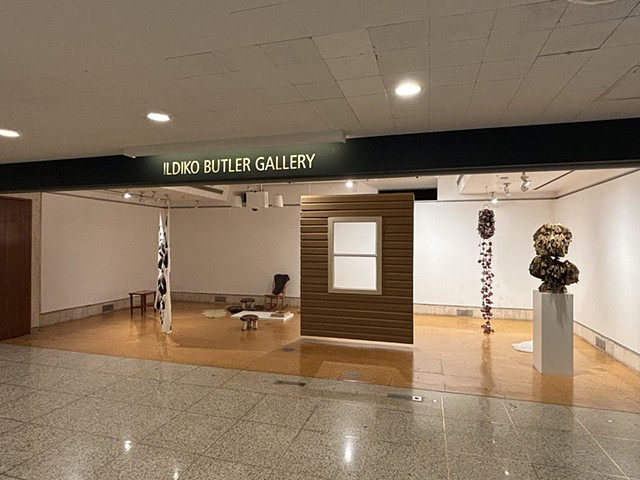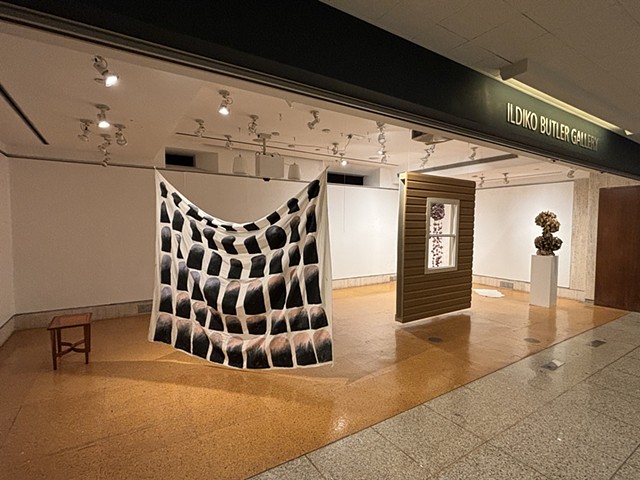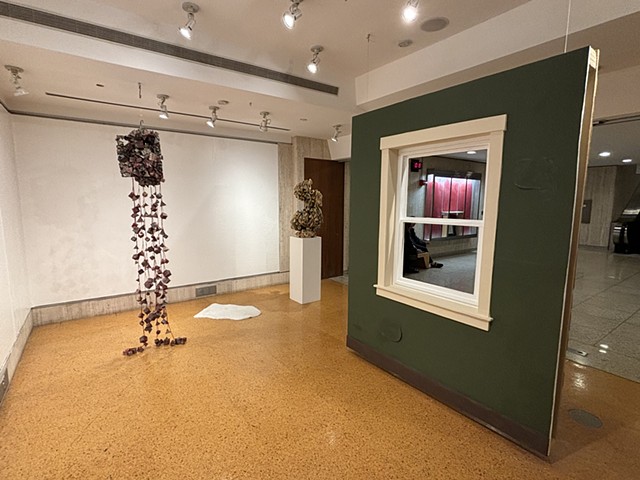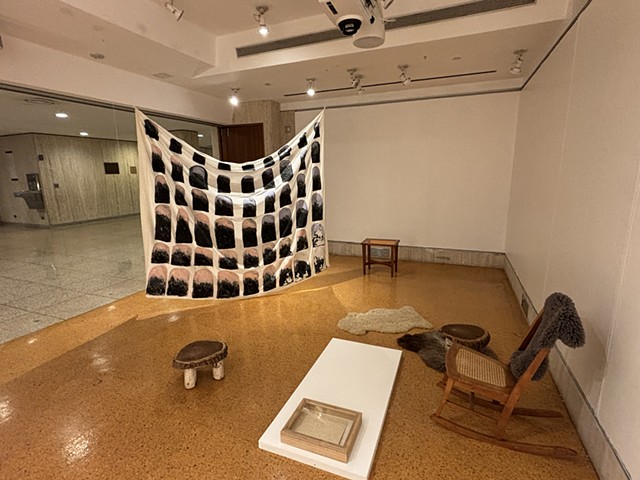JUST A HOUSE: Faculty Spotlight
JUST A HOUSE
Catalina Alvarez, Amie Cunat, Aseel Sawalha, Vincent Stracquadanio
Ildiko Butler Gallery
Reception: Friday, December 1 from 6:00-8:00PM
Fordham University and the Visual Arts Department is pleased to present Just a House, a group exhibition featuring the work of four faculty members.
How do we form feelings of belonging? Are there boundaries that describe the contour of these notions? What histories are they made from? Just a House explores ideas of displacement, familiarity, comfort, and connection through sculptural installation. Each artist uses a domestic material or motif, along with an element of suspension from the gallery’s ceiling to prompt conversation about the complicated, sometimes precarious nature of belonging.
Within Catalina Alvarez’s intimate installation, a grouping of two birch stools (by Peter Blasser), a wooden table (by Daniel Fishkin), a rocking chair, and animal skins invite a visitor to watch two chapters from her anthology film, Sound Spring (Seq. #5 & #7), projected onto a centralized plinth. Unfolding in a series of eight vignettes, Sound Spring explores the history of Yellow Springs, Ohio over hundreds of years, as narrated by its residents in comical scenes: one interviewee rollerblades and reads the village’s water meters, another stands on his head in a breakdancing freeze. The villagers describe American history—their ancestors' settlements after slavery, a friendship with Coretta Scott King, and Ohio’s Trail of Tears— among other more personal details of village life. By interacting with their own previously recorded media, villagers uncover layers of time and storytelling.
In Days I’ve Spent, Times I’ve Tried, Vincent Stracquadanio paints sequential rows of Coliseum-like archways on a bed sheet to describe a liminal space between structured architecture and soft installation; between positive and negative space; between conscious and dream worlds. With imagery that draws from Sicilian folkloric traditions, Etruscan frescoes, and Giallo horror films, Stracquadanio frequently uses patterns, gestural abstraction, or archetypical forms to flatten or expand space. The artist generates a purposeful lack of solidity and definition –as if ghostly forms are departing and floating through a dreamlike miasma—offering expressions of grief and longing.
Central points of tension acknowledge and defy the gravity of Aseel Sawalha’s objects. Lantern contains a multitude of painted hand-folded pages which are connected by a system of crocheted netting that cascades from the gallery’s ceiling. The organic entanglement of the vermillion thread contradicts the sharpness of the geometric elements it binds. Passages and Spooler are made of reformations of discarded Fordham books and other found objects (Christmas tree stand, discarded mail tubes). The artist’s work is informed by her ethnographic fieldwork research with Bedouin tribes, post-war Beirut, New York City women artists, and the art scene in Jordan and Palestine. Meticulously constructed, the sculptures are hybrid restructurings of found books and print matter modified by hand rolling and quilling, weaving, and paint, which mesh forms from modern and post-modern visual arts with techniques from traditional Arabic and Palestinian handicrafts.
Made from paper materials and paint, Amie Cunat’s structure –with ubiquitous siding on its façade and a hunter green interior—resembles an excerpt from a Midwestern ranch-style home. Assumptions about its locale and reference are complicated by its construction. Influenced by unnamable sentience within horror movies like the The Blob, The Thing, and Them! and false front architecture, Cunat’s object contains two Crappie gills that disrupt the logical continuity of its domestic container. Window and Gills, Tatami Tan is both alien and familiar; animal and built.




